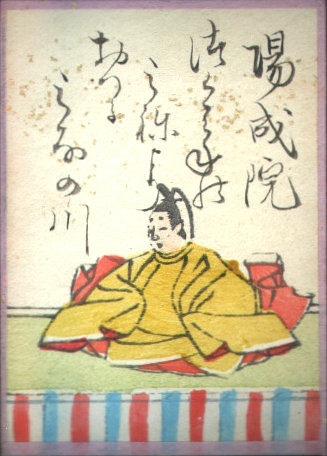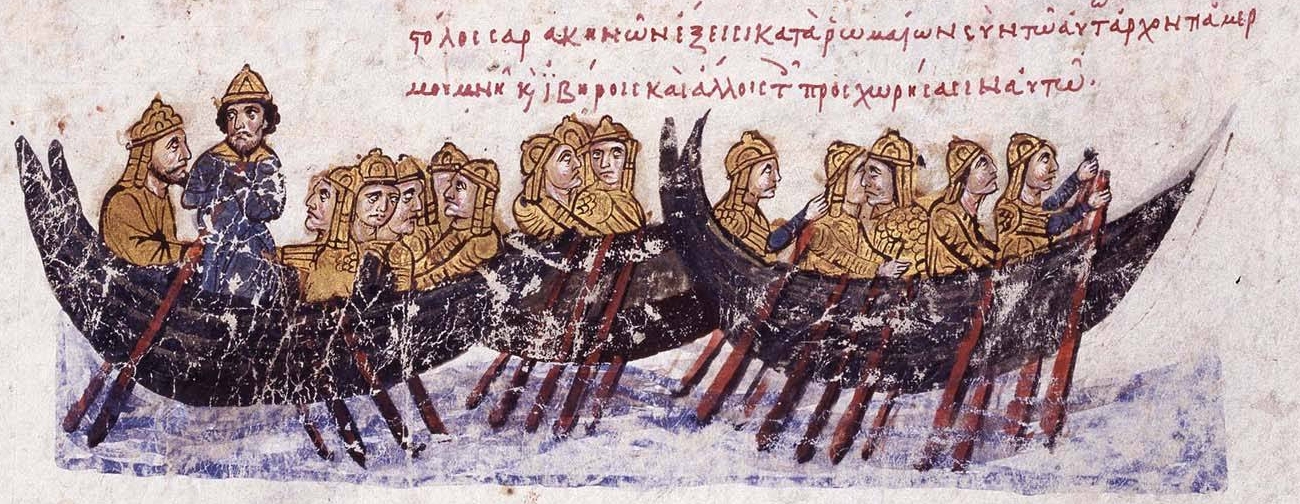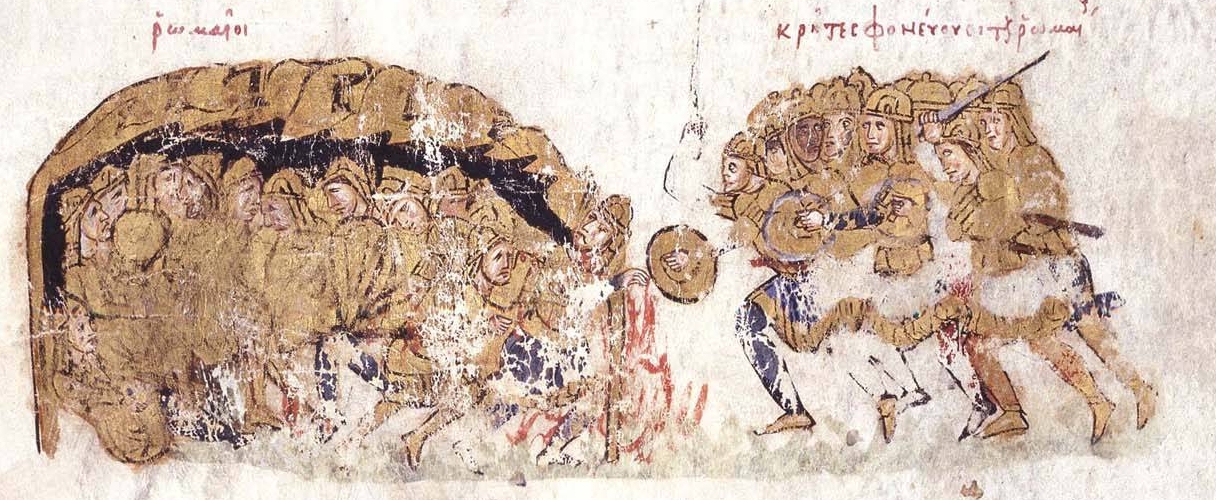|
949
Year 949 ( CMXLIX) was a common year starting on Monday (link will display the full calendar) of the Julian calendar. Events By place Byzantine Empire * Arab-Byzantine War: Hamdanid forces under Sayf al-Dawla raid into the theme of Lykandos, but are defeated. The Byzantines counter-attack and seize Germanikeia, defeating an army from Tarsus, and raiding as far south as Antioch. General (''strategos'') Theophilos Kourkouas captures Theodosiopolis (modern-day Erzurum) after a 7-month siege. Europe * A Byzantine expeditionary force under Constantine Gongyles attempts to re-conquer the Emirate of Crete from the Saracens. The expedition ends in a disastrous failure; the Byzantine camp is destroyed in a surprise attack. Gongyles himself barely escapes on his flagship. *Abd al-Rahman III the ''Caliph'' of Córdoba declares Jihad, preparing a large army & conquers the city of Lugo in the extreme North of Iberia. This raid shows to be one of the furthest raids Muslims in ... [...More Info...] [...Related Items...] OR: [Wikipedia] [Google] [Baidu] |
Theme (Byzantine District)
The themes or ( el, θέματα, , singular: , ) were the main military/administrative divisions of the middle Byzantine Empire. They were established in the mid-7th century in the aftermath of the Slavic invasion of the Balkans and Muslim conquests of parts of Byzantine territory, and replaced the earlier provincial system established by Diocletian and Constantine the Great. In their origin, the first themes were created from the areas of encampment of the field armies of the East Roman army, and their names corresponded to the military units that had existed in those areas. The theme system reached its apogee in the 9th and 10th centuries, as older themes were split up and the conquest of territory resulted in the creation of new ones. The original theme system underwent significant changes in the 11th and 12th centuries, but the term remained in use as a provincial and financial circumscription until the very end of the Empire. History Background During the late 6th and e ... [...More Info...] [...Related Items...] OR: [Wikipedia] [Google] [Baidu] |
Miroslav Of Croatia
Miroslav ( la, Miroslaus) was the King of Croatia from 945 until his death in 949 and a member of the Trpimirović dynasty. Reign He was the oldest son of Krešimir I and succeeded him as king in 945. During his reign, Croatia suffered a civil war started by the followers of his brother, Michael Krešimir II. Because of this, Miroslav lost most of his lands in Bosnia, and the Byzantines wanted to take back his holdings in Dalmatia. In his time, it is known that the Croatian navy was reduced to only 30 ships, while the infantry and cavalry had even more devastating losses in the civil war until Miroslav was finally killed by Pribina, Ban of Croatia in 949, and his younger brother, Michael Krešimir II, succeeded him as king. See also * List of rulers of Croatia This is a complete list of rulers of Croatia under domestic ethnic and elected dynasties during the Croatian Kingdom (925–1918). This article follows the monarch's title number according to Hungarian succession f ... [...More Info...] [...Related Items...] OR: [Wikipedia] [Google] [Baidu] |
Emirate Of Crete
The Emirate of Crete ( ar, إقريطش, Iqrīṭish or , ''Iqrīṭiya''; gr, Κρήτη, Krētē) was an Islamic state that existed on the Mediterranean island of Crete from the late 820s to the reconquest of the island by the Byzantine Empire in 961. Although the emirate recognized the suzerainty of the Abbasid Caliphate and maintained close ties with Tulunid Egypt, it was ''de facto'' independent. A group of Andalusian exiles led by Abu Hafs Umar al-Iqritishi conquered Crete in either 824 or 827/828, and established an independent Islamic state. The Byzantines launched a campaign that took most of the island back in 842-43 under Theoktistos, but the reconquest was not completed and would soon be reversed. Later attempts by the Byzantine Empire to recover the island failed, and for the approximately 135 years of its existence, the emirate was one of the major foes of Byzantium. Crete commanded the sea lanes of the Eastern Mediterranean and functioned as a forward base and h ... [...More Info...] [...Related Items...] OR: [Wikipedia] [Google] [Baidu] |
Michael Krešimir II Of Croatia
Michael Krešimir II (, ) was King of Croatia from 949 until his death in 969. He was a member of the Trpimirović dynasty. Michael Krešimir II was a son of Krešimir I and the younger brother of Miroslav, who preceded him as King of Croatia in 945. Krešimir was brought to the throne by the powerful Ban Pribina, who rebelled against the former king Miroslav for having his jurisdiction restrained from some areas. The civil war eventually ended with Miroslav's death in 949 and the reign of Mihajlo began. The Croatian kingdom reached its former glory during Michael's reign. He ravaged the Bosnian župas Uskoplje, Luka and Pleva, and eventually conquered the whole region of Bosnia that was originally lost during the reign of Miroslav. The Bosnian ban fled to Hungary, after realizing he couldn't fight back and, by 968, Michael pacified the local tribes, establishing full control. Mihajlo and his wife Helen of Zadar had good relations with the Dalmatian cities. Helen built the ... [...More Info...] [...Related Items...] OR: [Wikipedia] [Google] [Baidu] |
Constantine Gongyles
Constantine Gongyles ( el, ; ) was a Byzantine eunuch and court official who led a failed expedition against the Emirate of Crete in 949. Biography 300px, The Cretan Saracens defeat the Byzantines. Miniature from the '' Madrid Skylitzes'' Nothing is known of Constantine's early life, except that he came from Paphlagonia.. The ''Life of St. Basil the Younger'' hagiography indicates that he and his brother Anastasios were relatives of the eunuch Constantine Barbaros, who rose to power at court as a favourite of the powerful '' parakoimomenos'' Samonas and of Emperor Leo VI the Wise (r. 886–912). Constantine first rose to prominence in 913/4, when following the death of Emperor Alexander (r. 912–913), the Empress-regent Zoe Karbonopsina selected him and his brother as her personal councillors. On this occasion, Constantine was raised to the supreme noble rank of ''patrikios''. Constantine Gongyles wielded great influence during the regency of Zoe (914–919), but he fel ... [...More Info...] [...Related Items...] OR: [Wikipedia] [Google] [Baidu] |
Pribina, Ban Of Croatia
Pribina was a Croatian nobleman and politician who is the first historically attested Ban of Croatia, having served under kings Miroslav and Michael Krešimir II of Croatia. Pribina is known to have killed king Miroslav during a civil war in the kingdom and replaced him with Michael Krešimir II because the former had restrained his jurisdiction over some areas. He ruled over counties (županija) Gacka, Krbava and Lika, according to '' De Administrando Imperio''. He is also referred to in a charter as ''potens banus'', meaning "powerful ban". According to historian Tibor Živković, implying different chronological order of Croatian dukes and kings, Pribina should be identified with the same-named Duke of Lower Pannonia, Pribina, while Frankish archon Kotzil with Duke's son Kocel, both mentioned in '' De Administrando Imperio'' regarding the deposition of Miroslav in 861 and armed revolt by the Croats who were led by their Duke Domagoj Domagoj is a Croatian name of Slavic orig ... [...More Info...] [...Related Items...] OR: [Wikipedia] [Google] [Baidu] |
Sayf Al-Dawla
ʿAlī ibn ʾAbū l-Hayjāʾ ʿAbdallāh ibn Ḥamdān ibn al-Ḥārith al-Taghlibī ( ar, علي بن أبو الهيجاء عبد الله بن حمدان بن الحارث التغلبي, 22 June 916 – 9 February 967), more commonly known simply by his honorific of Sayf al-Dawla (, ), was the founder of the Emirate of Aleppo, encompassing most of northern Syria and parts of the western Jazira. The most prominent member of the Hamdanid dynasty, Sayf al-Dawla originally served under his elder brother, Nasir al-Dawla, in the latter's attempts to establish his control over the weak Abbasid government in Baghdad during the early 940s CE. After the failure of these endeavours, the ambitious Sayf al-Dawla turned towards Syria, where he confronted the ambitions of the Ikhshidids of Egypt to control the province. After two wars with them, his authority over northern Syria, centred at Aleppo, and the western Jazira, centred at Mayyafariqin, was recognized by the Ikhshidids and the A ... [...More Info...] [...Related Items...] OR: [Wikipedia] [Google] [Baidu] |
Caliphate Of Córdoba
The Caliphate of Córdoba ( ar, خلافة قرطبة; transliterated ''Khilāfat Qurṭuba''), also known as the Cordoban Caliphate was an Islamic state ruled by the Umayyad dynasty from 929 to 1031. Its territory comprised Iberia and parts of North Africa, with its capital in Córdoba. It succeeded the Emirate of Córdoba upon the self-proclamation of Umayyad emir Abd ar-Rahman III as caliph in January 929. The period was characterized by an expansion of trade and culture, and saw the construction of masterpieces of al-Andalus architecture. The caliphate disintegrated in the early 11th century during the Fitna of al-Andalus, a civil war between the descendants of caliph Hisham II and the successors of his '' hajib'' (court official), Al-Mansur. In 1031, after years of infighting, the caliphate fractured into a number of independent Muslim '' taifa'' (kingdoms). History Umayyad Dynasty Rise Abd ar-Rahman I became emir of Córdoba in 756 after six years in exile after t ... [...More Info...] [...Related Items...] OR: [Wikipedia] [Google] [Baidu] |
Siege
A siege is a military blockade of a city, or fortress, with the intent of conquering by attrition warfare, attrition, or a well-prepared assault. This derives from la, sedere, lit=to sit. Siege warfare is a form of constant, low-intensity conflict characterized by one party holding a strong, static, defensive position. Consequently, an opportunity for negotiation between combatants is common, as proximity and fluctuating advantage can encourage diplomacy. The art of conducting and resisting sieges is called siege warfare, siegecraft, or poliorcetics. A siege occurs when an attacker encounters a city or fortress that cannot be easily taken by a quick assault, and which refuses to Surrender (military), surrender. Sieges involve surrounding the target to block the provision of supplies and the reinforcement or escape of troops (a tactic known as "Investment (military), investment"). This is typically coupled with attempts to reduce the fortifications by means of siege engines, ar ... [...More Info...] [...Related Items...] OR: [Wikipedia] [Google] [Baidu] |
Abd Al-Rahman III
ʿAbd al-Rahmān ibn Muḥammad ibn ʿAbd Allāh ibn Muḥammad ibn ʿAbd al-Raḥmān ibn al-Ḥakam al-Rabdī ibn Hishām ibn ʿAbd al-Raḥmān al-Dākhil () or ʿAbd al-Rahmān III (890 - 961), was the Umayyad Emir of Córdoba from 912 to 929, at which point he founded the Caliphate of Córdoba, serving as its first caliph until his death. Abd al-Rahman won the ''laqab'' (sobriquet) () in his early 20s when he supported the Maghrawa Berbers in North Africa against Fatimid expansion and later claimed the title of Caliph for himself. His half-century reign was known for its religious tolerance. Life Early years Lineage and appearance Abd al-Rahman was born in Córdoba, on 18 December 890. His year of birth is also given as 889 and 891. He was the grandson of Abdullah ibn Muhammad al-Umawi, seventh independent Umayyad emir of al-Andalus. His parents were Abdullah's son Muhammad and Muzna (or Muzayna), a Christian concubine. His paternal grandmother was also a Christian, the ... [...More Info...] [...Related Items...] OR: [Wikipedia] [Google] [Baidu] |
Córdoba, Spain
Córdoba (; ),, Arabic: قُرطبة DIN 31635, DIN: . or Cordova () in English, is a city in Andalusia, Spain, and the capital of the Province of Córdoba (Spain), province of Córdoba. It is the third most populated Municipalities in Spain, municipality in Andalusia and the 11th overall in the country. The city primarily lies on the right bank of the Guadalquivir, in the south of the Iberian Peninsula. Once a Roman settlement, it was taken over by the Visigothic Kingdom, Visigoths, followed by the Umayyad conquest of Hispania, Muslim conquests in the eighth century and later becoming the capital of the Umayyad Caliphate of Córdoba. During these Islamic Golden Age, Muslim periods, Córdoba was transformed into a world leading center of education and learning, producing figures such as Maimonides, Averroes, Ibn Hazm, and Al-Zahrawi, and by the 10th century it had grown to be the second-largest city in Europe. Following the Siege of Córdoba (1236), Christian conquest in 1236, it ... [...More Info...] [...Related Items...] OR: [Wikipedia] [Google] [Baidu] |
Julian Calendar
The Julian calendar, proposed by Roman consul Julius Caesar in 46 BC, was a reform of the Roman calendar. It took effect on , by edict. It was designed with the aid of Greek mathematicians and astronomers such as Sosigenes of Alexandria. The calendar became the predominant calendar in the Roman Empire and subsequently most of the Western world for more than 1,600 years until 1582, when Pope Gregory XIII promulgated a minor modification to reduce the average length of the year from 365.25 days to 365.2425 days and thus corrected the Julian calendar's drift against the solar year. Worldwide adoption of this revised calendar, which became known as the Gregorian calendar, took place over the subsequent centuries, first in Catholic countries and subsequently in Protestant countries of the Western Christian world. The Julian calendar is still used in parts of the Eastern Orthodox Church and in parts of Oriental Orthodoxy as well as by the Berbers. The Julian calenda ... [...More Info...] [...Related Items...] OR: [Wikipedia] [Google] [Baidu] |








_(cropped).jpg)